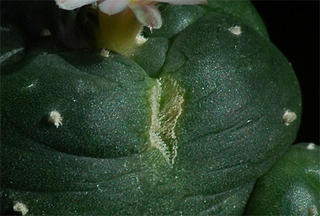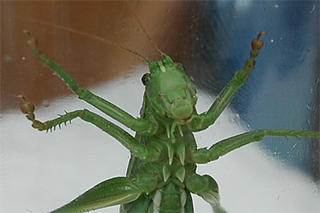For the third time this year my grafted Lophophora williamsii (SB 854; Starr Co, Tx) is flowering – quite an accomplishment from a plant only 18 months from seed (sowed February 29, 2004). This flower was also self-pollinated.

Flowering Lophophora williamsii
The two spent flowers can be seen below the current one.
< previous | next >
Monday, August 29, 2005
The power of grafting - IV
Monday, August 22, 2005
The power of grafting - III
My grafted Lophophora williamsii (SB 854; Starr Co, Tx) is flowering again (and yet another bud is in the works). Once again I had to self-pollinate the flower since none of my other plants are blooming.

Flowering Lophophora williamsii
Growth will tear us apart
The scion is growing so hard you can practically hear the epidermis squeaking. A couple of days ago it gave in to the pressure and burst – maybe triggered by the plant “rearranging itself”, starting to grow more ribs. The scion has grown to a width of 5 cm (~1.97’’), excluding the offshoots.
 .
.
Bursting Lophophora williamsii
The Echinopsis (Trichocereus) pachanoi stock refuses to give up the fight and is stubbornly growing yet another offshoot.
< previous | next >
Obregonia and Ariocarpus from seed – IV
The sowing bags have been open for the last week, and yesterday the seedling plants were removed from the bags and fully exposed to the real world environment. The 30+ Obregonia denegrii (VVZ 163; San Vicente, Tamaulipas) seedlings are growing vigorously, and I’m already wondering how to find room for all the plants ;-)

Obregonia denegrii seedlings
The 6 Ariocarpus fissuratus (PP 176; Big Bend, Texas) seedlings also started out convincingly but after growing a couple of diminutive tubercles each, their growth grinded to a halt. I’m a bit disappointed with the germination rate of these A. fissuratus seeds and will probably try again next year with seeds from a different supplier.
< previous |
Monday, August 15, 2005
Munching on Lophophora williamsii
Until lately my coldhouse grown Lophophora williamsii (SB 854; Starr Co, Tx; sowed May 1, 2004) were dazzling in their immaculate appearance – until some critter decided to munch on them.

Munched on Lophophora
The main shoot of my Cylindropuntia tunicata was maimed too. A search of the cacti revealed a great green bush-cricket (Tettigonia viridissima) hiding among the plants. I took the mug shot below before releasing the suspected culprit outdoors.
Captured great green bush-cricket
The harm is not too great and I expect the plants to fully recuperate from the damage.
Monday, August 08, 2005
The New Cactus Lexicon
I finally got around and ordered my ‘early subscriber’ copy of the The New Cactus Lexicon. The lexicon is prepared on behalf of the International Cactaceae Systematics Group (ICSG) by David Hunt et al. and will publish by March 2006 at the latest. The invitation to subscribe early expires at August 31, 2005. A full prospectus and order form is available online.
![]() “Planned as a successor to Backeberg's Cactus Lexicon, The New Cactus Lexicon will be the most scientifically authoritative conspectus of the Cactaceae published for nearly a century. It will be comprehensively illustrated in colour and is confidently expected to become the benchmark reference for all those with amateur or professional interests in the diversity, identification and conservation of cacti.”
“Planned as a successor to Backeberg's Cactus Lexicon, The New Cactus Lexicon will be the most scientifically authoritative conspectus of the Cactaceae published for nearly a century. It will be comprehensively illustrated in colour and is confidently expected to become the benchmark reference for all those with amateur or professional interests in the diversity, identification and conservation of cacti.”
I trust the lexicon will have in-depth coverage of Acharagma, Lophophora, Obregonia, Strombocactus etc. ;-)
Update - July 31, 2006
The lexicon arrived a couple of days ago – I’ll get back with more information when I’ve had a chance to study the books.
Update - September 17, 2006
The New Cactus Lexicon: A Review
All Time Most Popular Posts
-
Lophophora williamsii (peyote) populations have diminished in large areas of South Texas where peyoteros harvest the cactus for ceremonial ...
-
On various occasions I've been asked what growing media I'm using for my cactus plants. I don't have a set soil mix recipe as su...
-
Below is a list of retailers/nurseries selling cactus seed and plants. I've only listed vendors I've done business with. If you ar...
-
Most cacti are easily grown from seed - and with a little patience and care they can be grown into beautiful plants. Lophophora williamsi...
-
In last month’s post on the troubled Texan peyoteros I referred to Anderson’s article on the peyote situation in Texas. Given the importanc...
-
Yet another slightly off topic and probably not entirely politically correct post, but I couldn’t help noticing the similarity of my monstr...
-
Flowering stand of San Pedro cacti (Trichocereus pachanoi) To me the main draw of the San Pedro cactus ( Trichocereus pachanoi (syn. Ech...
-
In the June 2008 issue of the Cactus & Co magazine Jaroslav Šnicer, Jaroslav Bohata, and Vojtěch Myšák described a new Lophophora spec...
-
There seems to be an increased focus on the alarming Texas peyote situation. A couple of weeks ago the Houston Press published a mournful, i...
-
I spent two weeks working in Delhi, India during January. I had one weekend off and had planned to spend it in Delhi at my own leisure, but ...


















